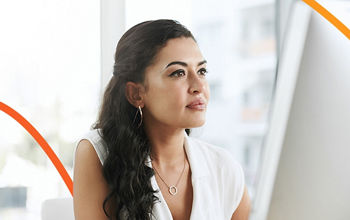Mastering W-9 Forms: A Comprehensive Overview for Employers
November 12, 2024
W-9 forms are necessary for reporting independent contractor payments to the IRS. Learn what they capture and how they support Form 1099s.
- Reviewed by Paylocity's Compliance & Government Relations Team

What is a W-9?
Form W-9 (a.k.a. Request for Taxpayer Identification Number and Certification) is an Internal Revenue Service (IRS) tax document used to obtain essential taxpayer information from certain individuals and entities an organization pays.
Commonly requested from independent contractors, freelancers, and other non-employees, a W-9 form captures, among other details, the payee’s name, address, and taxpayer identification number (TIN) for use in preparing other IRS tax documents and forms (e.g., Form 1099).
In some situations, such as payments related to investments, interest, or dividends, a W-9 form can also certify a payee’s exemption from backup withholding.
Key Takeaways
- W-9 forms collect required tax information from non-employees that payer organizations need for other tax reports, such as Forms 1099 or 1098.
- Form W-9 serves the same purpose as a W-4 form, but for contractors, freelancers, consultants, etc., instead of hired employees.
- Penalties for failing to provide information, providing incorrect information, or falsifying information include fines and potential imprisonment.
What is Backup Withholding?
Since contractors and freelancers aren’t hired employees, payments to them and other non-employees aren’t subject to FICA taxes (i.e., Medicare and Social Security). Instead, self-employed individuals pay Self-Employed Contributions Act (SECA) taxes, which are calculated on 1099 forms and tracked by each individual’s TIN.
Backup withholding occurs when a payee fails to provide (or doesn’t have) a TIN to report on Form 1099. In such cases, the payer can withhold and remit up to 24% of the total payment to guarantee all corresponding SECA taxes are covered.
Form W-9 vs Form W-4
IRS Form W-9 serves a similar purpose as Form W-4 in that both forms gather essential tax information for others to use when preparing tax reports to the IRS. The difference is that one is used for hired employees (W-4) and the other for non-employees (W-9).
|
Role Type |
Tax Information Form* |
Tax Reporting Form |
|
Non-Employee |
W-9 Form |
|
|
Hired Employee |
*Such forms don’t have to be submitted to the IRS but should be kept on file for at least a few years.
Who is the W-9 for?
A W-9 form is primarily used by individuals and entities who receive payment for services but aren’t hired as traditional employees by the payer organization. In other words, independent contractors, freelancers, consultants, vendors, and other non-employee roles should complete a W-9 if they expect to be paid $600 or more by an organization that tax year.
Ideally, businesses should request a completed W-9 at the start of the professional relationship (i.e., before any work begins). Getting a W-9 form early benefits all parties as it avoids potential withholding issues and ensures accurate year-end reporting to the IRS, thus saving substantial time and energy for everyone involved.
W-9 Instructions
Payees will need a few pieces of information when completing a W-9 tax form:
- Business or personal name and address
- The business’ tax classification and TIN
- Any applicable exemptions

|
Line |
Description |
|
1 |
Enter the payee’s full legal name as it appears on their federal income tax returns. It should align with tax records for any business associated with the payee’s TIN. |
|
2 |
Enter the payee’s business name, disregarded entity name, trade name, Doing Business As (DBA) name, etc. This is used when it’s legally necessary or relevant to differentiate the legal name provided in Line 1 from any individual’s owner or disregarded entity names and any organization’s trade or DBA names. Those who don’t have a business, trade, or DBA name can leave this line blank. |
|
3a |
Select the box corresponding to the federal tax classification for the individual or entity named in Line 1 based on how that entity reports income to the IRS. LLCs owned by a single person and disregarded for federal tax purposes should use the Individual/Sole-Proprietor box. Partnership LLCs should use the LLC box and record which type of partnership (C-Corp., S-Corp., or Partnership) in the provided space. |
|
3b |
Select the box if the trust, estate, partnership, or partnership LLC has foreign partners, owners, or beneficiaries. |
|
4* |
Enter the code that exempts the business or entity from backup withholding or Foreign Account Tax Compliance Act (FATCA)** reporting. Refer to Form W-9’s instructions for a breakdown of every backup withholding exemption code (1–10) and FACTA reporting exemption code (A–M). |
|
5 & 6 |
Enter the address where the payer should mail the completed Form 1099. This information should match what’s listed on an individual’s income tax return or entity’s federal tax return. |
|
7 |
Enter any account numbers relevant to the income associated with this form. |
|
Part I |
Enter the payee’s Social Security Number (SSN) or Employer Identification Number (EIN). Typically, entities (e.g., partnerships, corporations, estates, etc.) will use an EIN, while individuals (e.g., single-member LLCs, sole proprietorships, disregarded entities, etc.) will use an SSN unless they also have an EIN. In such situations, either can be used. Resident aliens without an SSN can use their Individual Taxpayer Identification Number (ITIN) instead. |
|
Part II |
Sign and date the form to certify the statements within Part II are correct. |
* Most individuals can leave this line blank.
**FACTA requires foreign financial institutions to identify and report on accounts held by U.S. taxpayers to help ensure U.S. citizens, even those living abroad, pay taxes on worldwide income.
W-9 Form Download
Download a fillable W-9 form and additional instructions from the IRS’ About Form W-9 page. Businesses and organizations can then supply the blank W-9 form to payees electronically or in print, although some prefer to use payroll tax software that seamlessly furnishes, records, and stores the form for future use.
Tax Form W-9 Penalties
The 2024 W-9 Form lists a few penalties for payees who either fail to provide the requested information, falsify information, or provide incorrect data.
- Unless due to a reasonable cause and not willful neglect, failure to provide a TIN results in a $50 penalty for each infraction and makes the total payment subject to backup withholding.
- Trying to avoid backup withholdings by providing false information with no reasonable basis comes with a $500 penalty.
- Willfully falsifying the certifications and affirmations listed on Form W-9 can incur criminal penalties, including fines and imprisonment.
Requesters who violate federal law by misusing a payee’s TIN can also become subject to civil or criminal penalties.

Get Taxes Done Right, Without the Stress
We know there's a lot that goes into preparing and filing payroll tax forms. Save time and get support from our expert team. As a Registered Reporting Agent with the IRS, we can help prepare and file all the necessary forms you need to remain compliant - even in the face of changing legislation. Learn more here.



